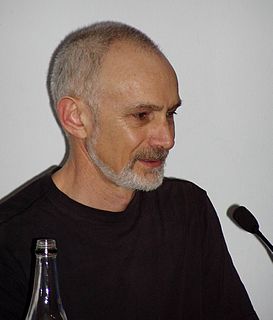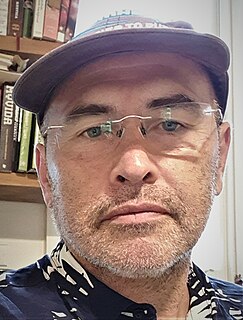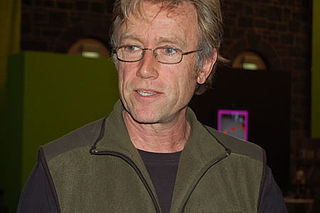
Sean Christopher McMullen is an Australian science fiction and fantasy author.

Damien Francis Broderick is an Australian science fiction and popular science writer and editor of some 74 books. His science fiction novel The Dreaming Dragons (1980) introduced the trope of the generation time machine, his The Judas Mandala (1982) contains the first appearance of the term "virtual reality" in science fiction, and his 1997 popular science book The Spike was the first to investigate the technological singularity in detail.
George Reginald Turner was an Australian writer and critic, best known for the science fiction novels written in the later part of his career. His first science fiction story and novel appeared in 1978, when he was in his early sixties. By this point, however, he had already achieved success as a mainstream novelist, including a Miles Franklin Award, and as a literary critic.

David Geddes Hartwell was an American critic, publisher, and editor of thousands of science fiction and fantasy novels. He was best known for work with Signet, Pocket, and Tor Books publishers. He was also noted as an award-winning editor of anthologies. The Encyclopedia of Science Fiction describes him as "perhaps the single most influential book editor of the past forty years in the American [science fiction] publishing world".

Russell Blackford is an Australian writer, philosopher, and literary critic.
The Ditmar Award is Australia's oldest and best-known science fiction, fantasy and horror award, presented annually since 1969, usually at the Australian "Natcon". The historical nominations and results of the Award follow.

Paul Voermans is an Australian performer, community IT advocate, and writer of prose and poetry, whose work includes a number of novels. Published as science fiction, the novels contain elements of surrealism, horror, and humour. They have been compared to RA Lafferty and Douglas Adams.

Paul Collins is an Australian writer and editor who specializes in science fiction and fantasy.

Terence William (Terry) Dowling, is an Australian writer and journalist. He writes primarily speculative fiction and dark fantasy though he considers himself an "imagier" – one who imagines, a term which liberates his writing from the constraints of specific genres. He has been called "among the best-loved local writers and most-awarded in and out of Australia, a writer who stubbornly hews his own path ."
Terror Australis: the Australian Horror and Fantasy Magazine (1988–1992) was Australia's first mass market horror magazine. It succeeded the Australian Horror and Fantasy Magazine (1984–87) edited by Barry Radburn and Stephen Studach. AH&FM was the first semi-professional magazine of its kind in Australia to pay authors. After working on the production crew of AH&FM, when Radburn eventually suspended publication, Leigh Blackmore took over the subscription base and with co-editors Chris G.C. Sequeira and Bryce J. Stevens founded Terror Australis. Kevin Dillon, a longtime Australian sf fan who had belonged to the Australian Futurians had the role of 'Special Consultant' for financial support and proofreading work on the magazine.
Kathryn Elizabeth Cramer is an American science fiction writer, editor, and literary critic.
Terror Australis: Best Australian Horror was Australia's first original mass-market horror anthology for adults. It was edited by Leigh Blackmore..

Rick Kennett is an Australian writer of science fiction, horror and ghost stories. He is the most prolific and widely published genre author in Australia after Paul Collins, Terry Dowling and Greg Egan, with stories in a wide variety of magazines and anthologies in Australia, the US and the UK.
Van Ikin is an academic and science fiction writer and editor. A professor in English at the University of Western Australia, he retired from teaching in 2015 and is now a senior honorary research fellow. He has acted as supervisor for several Australian writers completing their post-graduate degrees and doctorates — including science fiction and fantasy writers Terry Dowling, Stephen Dedman, and Dave Luckett — and received the university's Excellence in Teaching Award for Postgraduate Research Supervision in 2000.
The William Atheling Jr. Award for Criticism or Review are a Special Category under the Ditmar Awards. "The Athelings", as they are known for short, are awarded for excellence in science fiction and speculative criticism, and were named for the pseudonym used by James Blish for his critical writing.

Bruce Gillespie is a prominent Australian science fiction fan best known for his long-running sf fanzine SF Commentary. Along with Carey Handfield and Rob Gerrand, he was a founding editor of Norstrilia Press, which published Greg Egan's first novel.
Science Fiction magazine is a long running science fiction critical journal published in Australia by SF academic Van Ikin from the University of Sydney and later the University of Western Australia. Contributing editors have included writer Terry Dowling and book collector and reviewer Keith Curtis.

Dreaming Down-Under is a 1998 speculative fiction anthology edited by Jack Dann and Janeen Webb.
Steven Paulsen is an Australian writer of science fiction, fantasy and horror fiction whose work has been published in books, magazines, journals and newspapers around the world. He is the author of the best selling children's book, The Stray Cat, which has seen publication in several foreign language editions. His short story collection, Shadows on the Wall: Weird Tales of Science Fiction, Fantasy and the Supernatural), won the 2018 Australian Shadows Award for Best Collected Work, and his short stories have appeared in anthologies such as Dreaming Down-Under, Terror Australis: Best Australian Horror, Strange Fruit, Fantastic Worlds, The Cthulhu Cycle: Thirteen Tentacles of Terror, and Cthulhu Deep Down Under: Volume 3.








